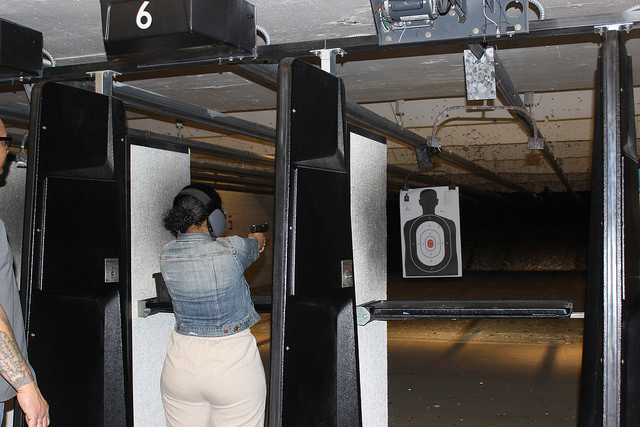Guns on campuses won’t stop shootings
DVC student Nima Aidara at the Dublin range with an instructor
May 10, 2018
Even though gun control and regulation has been an issue for a long time now and that the tragic events these past few months have raised awareness on this sensible topic, changing gun’s regulation continues to be a brain teaser.
Unfortunately, every mass shooting — whether committed in a school or not — raises two different arguments: more guns in order to protect oneself from the next crazy shooter, or striking the problem at its roots by rethinking total gun regulation.
We could legitimately think that the Florida’s shooting in February might have made the Trump administration rethink concealed carry laws on campuses. It didn’t.
“If you had a teacher who was adept with the firearm, they could end the attack very quickly,” Trump said after listening to a series of emotional stories and pleas to enhance school safety at the White House on Feb. 21. Trump is basically sticking to the National Rifle Association’s mantra “The only thing that stops a bad guy with a gun is a good guy with a gun.”
Let’s try to walk through that idea logistically. It would be hard to arm the teachers throughout the country, first of all because of the cost of such an operation.
According to the Washington Post’s estimations, we would essentially be adding 50 percent to the size of the military by mandating that nearly three-quarters of a million people be trained and prepared to take up arms to defend civilians. Given the minimal training to every teacher, just enough to pass the safety requirement for gun ownership, would cost more than $71 million. Even if these are rough estimations, they still give a great idea of the number of people who would need to be trained and armed and what that would cost.
Second of all, what kind of training? Trump stated on Feb. 22, “(Teachers would) go for special training and they would be there and you would no longer have a gun-free zone.” The term “special training” is to say the least, very unclear. The cost of this training would be enormous and unrealistic.
Moreover, Americans are not in favor of seeing teachers armed in schools. According to a 2017 Pew Research Center survey, more than half of U.S. adults (55%) would oppose allowing teachers and officials to carry guns in K-12 schools, including 36% who said they would strongly oppose such a proposal. Still, a sizable minority (45%) said they favored allowing teachers to carry guns in schools.
With such a sizable split in public opinion, it makes more sense to leave the choice of whether or not to allow guns on university premises to the states. Last year, Arkansas and Georgia passed legislation to allow students and faculty to carry guns on college campuses. For now, 12 states allow people to carry guns on public college and university campuses and in 2017, campus carry bills were introduced in at least 16 others states.
Another argument in favor of having guns on campuses is that when shooters are targeting places to attack they choose gun free zones because they don’t have to worry about people shooting back at them. This is a flawed assumption.
Trump tweeted out on March 12 that, “If schools are mandated to be gun free zones, violence and danger are given an open invitation to enter. Almost all school shootings are in gun free zones. Cowards will only go where there is no deterrent!” His position on gun free zones is clear but isn’t supported by any data.
A 2017 John Hopkins University study states that “there is no evidence that mass shooters target so-called ‘gun-free’ zones. Rather than choosing a target because it is perceived to be ‘gun free,’ perpetrators often have some prior connection to the location and/or the victims targeted.”
Trump’s position on the matter is influenced by the fact that the NRA spent nearly $11.5 million to support Donald Trump and another $19.75 to oppose Hillary Clinton. That’s over $31 million spent on one presidential race, according to Fortune magazine.
The center of the problem here is that this funding raises a conflict of interest. The president can’t objectively impose changes in order to protect the population when those changes conflict with the interests of the lobbying group that helped put him in power.
The NRA also successfully lobbied Congress to introduce the Dickey Amendment, which stopped the Center for Disease Control and Prevention from receiving funding to research gun violence in response to a 1993 CDC study that found that guns in households were associated with an increased risk of homicides.
By extension, allowing gun on campuses would just avoid dealing with the real problem; we should focus on preventing these mass shootings instead of trying to stop them while they are happening.
Yes, arming teachers may reduce the victims during an attack but it is an expensive, impractical idea that does not handle the problem at its roots.







































































